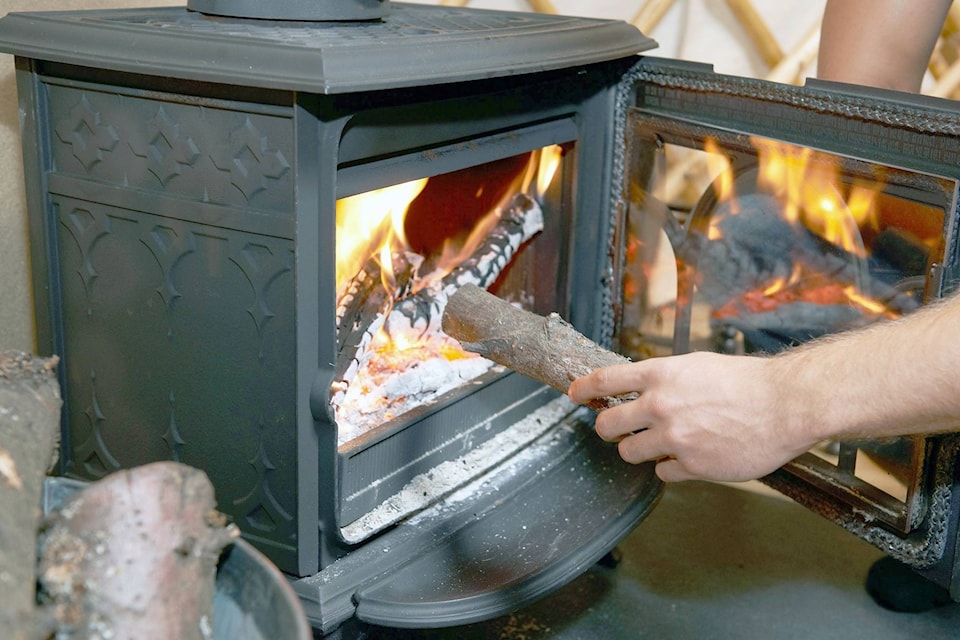The industry association for woodstove producers is fighting back against measures by Comox Valley local governments to curb use of woodstoves as a heating source.
The Hearth, Patio & Barbecue Association of Canada (HPBAC) recently launched a publicity campaign to “overturn the ban” in this area, including a website devoted to the issue. Adam De Caire, the association’s director of public affairs, told The Record that they are disappointed by the actions of local governments in recent years that pose obstacles for the inclusion of new, cleaner woodstoves in homes. The campaign is the first of its kind for the HPBAC and went live in late January.
“This campaign seemed like the logical next step after a disappointing level of engagement/consultation from local municipalities,” he said. “Banning future installations is the easy path for municipalities, but does not make a measurable improvement to air quality.”
The goal of the HPBAC campaign is to let residents know about the local restrictions as well as educate them on the wood-burning stoves sold in 2021 versus misconceptions they might have. One of their arguments is that the newer stoves burn cleaner with far less particulate matter.
“If a resident sees a neighbour’s chimney letting off large amounts of smoke, then it is highly likely that the offender is using an appliance that is many years or decades old,” De Caire said.
Stoves sold before 1988 had no limits on emissions. The HPBAC’s data show old stoves could emit 40-50 grams of particulate matter per house. The post-1988 stoves might emit just over eight, with further reductions since 2015. A stove sold and installed today in B.C. now can emit a maximum of 2.5 grams per hour, De Caire added.
As to what prompted this response from the industry, Courtenay, for example, updated its bylaw in May 2020, to restrict solid fuel-burning appliances either to new buildings or through renovations to existing ones. Since December 2018, Cumberland has prohibited woodstoves in new residential buildings, to go with a ban on yard waste and land-clearing burning from 2017. Comox’s 2019 bylaw bans wood-burning appliances in new and existing construction, though allows for the replacement of an existing unit with a higher-efficiency model.
RELATED STORY: Comox council says no to wood stoves in renos and construction
RELATED STORY: ‘Hot spot’ wood smoke areas identified in Comox Valley
Clean-air advocates, on the other hand, are worried about the prospect of more woodstoves in the Comox Valley. They point to evidence that the area already has some of the poorest air quality in the province, especially in the cold winter months when more people are burning.
“We need to cap the numbers of stoves and start reversing the trend,” said Jennell Ellis of Breathe Clean Air Comox Valley. “From our point of view, these bylaws that industry are fighting are just one small step.”
The organization has a Facebook group with nearly 300 members. It also includes information about air quality threats on its website, and links to the province’s air quality index and pollution numbers. The group also cites reports from the BC Lung Association and the provincial government that note the community’s high particulate numbers for the area not only around the Georgia Strait region but the province as a whole.
Breathe Clean Air Comox Valley is not convinced by arguments about new cleaner woodstoves, saying the evidence the industry provides is based on optimum use, not necessarily on stoves that have been around for a few years.
“Even the best burners are still putting out way more pollution,” Ellis said. “If we’re going to clean up our air, we can’t keep putting in more woodstoves.”
Woodstoves, unlike other heating sources, she added, can be fuelled with anything, and there is too little control about what people are actually burning.
“You have no control over what people are putting into it,” she said.
The Comox Valley Regional District has responded to air quality issues by establishing an airshed round table. However, Ellis questions why, if there is a person from the industry at the table, is the industry then turning around and fighting local government measures aimed at improving air quality.
From HPBAC’s point of view, De Caire said the association is part of the round table but is disappointed that local governments enacted their bans.
“The City of Courtenay preempted the work of this group by imposing a ban … with no consultation of the industry, and as far as we can see, of the community at large. We have experienced a similar lack of consultation or engagement from the Town of Comox and the Village of Cumberland,” he said.
(This story has been updated to add information from the Town of Comox.)
mike.chouinard@comoxvalleyrecord.com
Like us on Facebook and follow us on Twitter.
